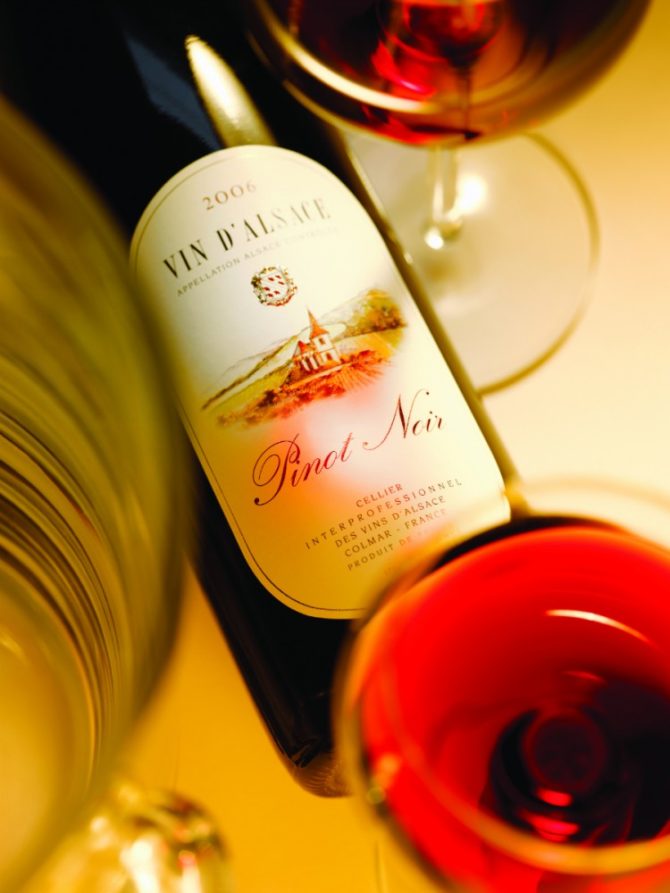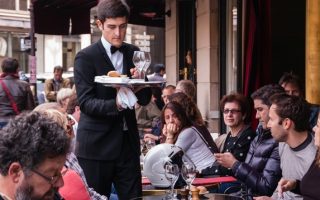A Tour of Alsace Wines

Alsace is a land of idyllic medieval villages nestled cosily among voluptuous, fertile hillsides which are peppered with majestic church steeples, castle ruins, riotous flower displays and pastel-coloured timbered cottages. The air is an intoxicating contradiction of spicy fruitiness and mineral freshnesss – it is as if the vines are breathing life into the villages. With its magic trilogy of history, culture and gastronomy set against the vividly colourful backdrop of viticulture, the region makes a perfect picture.
France had over 160 wine-growing districts by the end of the first millennium and Alsace is one of the oldest. Indeed, as far back as the Middle Ages, Alsacien wines were reputed to be among the best in Europe. The region has been passed back and forth between Germany and France for much of its existence. Yet despite this continual upheaval and the destruction caused by times of war, Alsace’s wine trade struggled on. Many of the region’s most reputable names are long-established, such as Dopff (1574), Trimbach (1626) and Hugel (1637).
This is the perfect place to enjoy an idle wine and gastronomy tour, and the 170 kilometre-long Route des Vins, which runs around the base of the Vosges mountains and alongside the banks of the Rhine River, is tourist-orientated without being kitsch or gaudy. The wineries which offer tastings to members of the public are located in villages, making them accessible even by foot.
There are seven major grape varieties in Alsace: Pinot Noir, Gewürztraminer, Pinot Blanc, Sylvaner, Pinot Gris, Riesling and Muscat. Some 92 per cent of Alsace and Alsace Grand Cru wines are dry, aromatic whites. Alsace’s appellations are unique in France because the region’s wines are labelled according to grape variety, as opposed to the vineyard. The vineyard or village is not mentioned unless the wine is a Grand Cru.
Alsacien wines are then organised by quality levels and belong to either the appellation ‘AC Alsace’ or ‘AC Grand Cru’. The appellation ‘Crémant d’Alsace’ is for sparkling wine which is produced in the same way as Champagne, mainly from Pinot Blanc grapes. Then there are levels of ripeness, either ‘Vendanges Tardives’ (Late Harvest), made using grapes which are picked later than normal, or ‘Sélection de Grains Nobles’ (Selection of Noble Grains).
Although the region may appear traditional, it is one of the most forward-thinking in Europe and this trait is seeing its vineyards embrace the future, as Alsacien wines are certain to change as a result of increasingly warmer harvests.
Traditionally, Alsace’s white grape varieties have always done so well because of long, cool hang times and the region’s patchwork of granite, limestone, gneiss, schist and sandstone soils, which impart acidity and structure to the wine. The region’s vineyards are also planted on slopes rather than in valleys, which provide good drainage and require the plants to grow deep roots.
However, the topography that once protected vines from the cold – such as the majestic Vosges mountain range, which created a temperate micro-climate away from the ocean – is now helping the warmer temperatures to remain land-locked.
Today, winemakers are saying that their whites are lacking acidity because of the heat, and their Pinot Noirs are taking on an ampleur and body rivalling some of the Burgundy appellations. There is even talk of planting other red varieties in this changing landscape. Whatever happens, you can be sure that there will always be magic in Alsace’s wines.
Perfect Pairings
Alsace boasts many specialities which perfectly marry with its wines. Fresh, fruity Sylvaner is ideal with a salade Vosgienne (mushrooms, red potatoes, Munster cheese, cumin, smoked lardons, croûtons and poached eggs) or flammenküeche (flatbread topped with fried onions, cream and smoked bacon).
Riesling, the pride of Alsace with its delicate fruit and subtle bouquet, is the perfect mate for choucroute garnie (a dish of boiled meats, sauerkraut and potatoes) or with a savoury kougelhopf (a filled brioche featuring, for example, salmon or pike). The full-bodied aromatic Gewürztraminer, meanwhile, is ideal with spicy exotic dishes, strong cheeses or the famous tarte aux pommes à l’alsacienne.
Tokay Pinot Gris, which falls between the steely crispness of Riesling and the sweeter opulence of Gewürztraminer, is perfect for baeckaoff (a marinaded, slow-cooked meat stew with onions, potatoes and seasonings).
Alsatian Pinot Noir is especially good with presskopf (a terrine of fresh wild salmon, lobster and oysters in a creamy sauce of caviar, parsley, tarragon and chives).
For its part, the fresh and easygoing Pinot Blanc pairs with almost anything but is best with fish, and the light, refreshing and crisp Crémant d’Alsace is akin to Champagne, as it can pair with an entire meal, from hors d’oeuvres to dessert.
Top Tastes
Eight fabulous vintages which will give your senses a tour of Alsace’s unique terroir, and set you off hunting for more of the region’s wines…
? Muscat Reserve Particulière, Henri Ehrhart, 2012
At 12% ABV (Alcohol By Volume), as it should be, this classic from the Ammerschwir- based producer is packed with natural acidity and aroma.? Sylvaner AOC, Rolly Gassmann, Reserve Millesime, 2010
Again, at 12% ABV, the beauty of this grape and its terroir is allowed to shine, proving that Sylvaner, when done properly, is never boring.
? Riesling Reserve, Domaine Trimbach, 2011
This Riesling from one of Alsace’s biggest houses is dry, clean, minerally and crisp, just as it should be. Lovely.
? Pinot Gris, Hugel & Fils, 2010
At 14% ABV, Pinot Gris should be getting ‘flabby’, but not when it is in the hands of the magic Hugels. A wine full of personality and structure.
? Gewürztraminer AOC, Rolly Gassman, 2002
A fleshy, seductive beauty which retains its fresh, mineral and spicy elegance.
? Brand Grand Cru Riesling, Cave de Turckheim, 2008
Despite the vintage, the granite slopes of this Grand Cru helped keep the alcohol down, to 12.5% ABV, and the acidity clean and crisp.
? Schoenenbourg Grand Cru Riesling, Dopff au Moulin, 2009
Although, at 13.5% ABV, this is getting fairly heavy for a Riesling, it is the terroir and craftsmanship of the Dopff au Moulin house which saves the vintage.
? Sommerberg Jeunes Vignes Grand Cru Riesling, Domaine Albert Boxler, 2008
A rich, ripe wine, with a touch of the heat of that year – it does boast a 13.5% ABV but, nevertheless, is still delectable.
Linda Johnson-Bell is the author of Pairing Wine and Food: A Handbook for All Cuisines. For more information, visit her website: www.thewinelady.com
Originally published in the February-March 2014 issue of France Today
Share to: Facebook Twitter LinkedIn Email
Leave a reply
Your email address will not be published. Required fields are marked *



